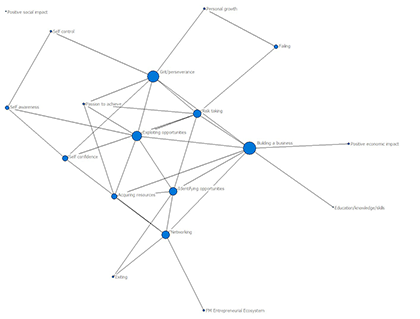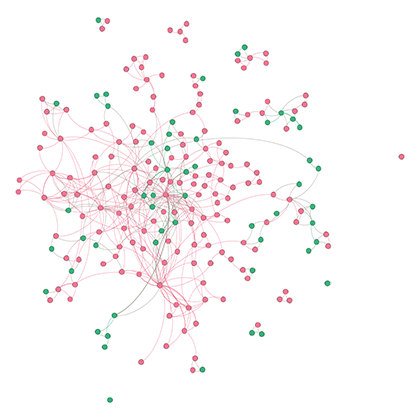Ask A Researcher
March 2019
Learning from Fargo: An Exploration of the Fargo-Moorhead Entrepreneurial Ecosystem

Joshua Marineau is an Assistant Professor of Management in the College of Business Management and Marketing department at North Dakota State University (NDSU). His research focuses on positive and negative social networks in the workplace. Specifically, how interpersonal conflict influences individual outcomes, as well as how individuals perceive their own and others’ conflict within the organization. He received his Ph.D. from the University of Kentucky’s Gatton College of Business and Economics. Onnolee Nordstrom also is an Assistant Professor in the College of Business at NDSU. Her research has examined a variety of questions pertaining to entrepreneurship, family business, philanthropy, and community development. She works with NDSU’s Research and Tech Park and the College of Business’ Entrepreneurial Initiatives to provide opportunities for NDSU students to develop an entrepreneurial mindset and skills to become innovative future leaders. She received her Ph.D. from the University of Alberta in Canada. In this article they highlight a number of key findings from their research on the Fargo-Moorhead entrepreneurial community.
Today, rural areas are confronted with many challenges. For instance, many have watched their dominant industries such as agriculture, mining, and lumber decline and “brains drain”. Energizing entrepreneurship has become a primary strategy for countering these trends and an attractive economic development tool. This is because entrepreneurship creates wealth, not just wages. And the wealth created by entrepreneurs is reinvested in the community. This is more beneficial for revitalization than just job creation, which brings wages to rural communities but does not always keep this corporate wealth within the boundaries of the community. Entrepreneurs in rural areas are more likely to become community leaders and philanthropists. Thus, entrepreneurship generates a broader set of benefits to local communities, engages civic leaders, emboldens students, and creates a culture of venture and wealth creation.
Fargo-Moorhead is one community that has embraced this challenge and begun working to catalyze entrepreneurship. Fargo-Moorhead has expanded its economy into food processing, manufacturing, technology, retail trade, higher education, and healthcare. According to the Marion Kauffman Foundation, a U.S.-based non-profit organization which tracks entrepreneurial activity in the United States, the Fargo-Moorhead area ranks third in growth entrepreneurship, and seventh in startup activity for small states over the most recent five-year span (kauffman.org). Additionally, a study published by Forbes (Badenhausen, 2014), ranked Fargo as the best small city in the nation to start a business. While many other small American cities have struggled, the Fargo-Moorhead community has grown its population, revitalized its downtowns, and become an important focal point for many professions, including government, education, medicine, retailing, and manufacturing.
These reasons helped us to realize why studying Fargo-Moorhead’s entrepreneurial scene could be interesting and illuminating. Ultimately, we felt that studying the Fargo-Moorhead community could provide us with insight into the cultural and social conditions that build support for entrepreneurial activity, particularly in more rural areas. Our multi-step approach was informed by a broad interest in understanding the culture within this successful entrepreneurial ecosystem. We conducted over 50 interviews with people active within the Fargo-Moorhead startup community, attended many local events, and developed a survey instrument that allowed us to capture individual understanding of entrepreneurship and to depict their social networks. This resulted in a dataset that contained 100s of pages of transcripts and a database depicting the relational ties among 550 individuals and the connections among 100s of local organizations. In this dataset 95% of the individuals were from Fargo. Thirty-four percent of the men and 29% of the women in our sample were entrepreneurs or founders. Nearly three-quarters of people were with for-profit organizations.
We were interested in determining whether individuals within the Fargo-Moorhead ecosystem thought of entrepreneurship in a similar way and if so what this shared way of thinking about entrepreneurship looked like. This, we felt, was important because the way in which individuals think about entrepreneurship influences how it is practiced, and what ventures are deemed legitimate and ultimately supported. We used a method called cultural consensus methodology to capture each individual’s beliefs about how strongly a set of relevant entrepreneurial concepts were related to one another, and to what degree. For example, they were asked to rate on a 1-7 scale (not related to strongly related), how each term related to each other term for all possible combinations. Some of the terms were behaviors (e.g., identifying opportunities, networking, risk-taking, starting a business); individual attributes (e.g., perseverance, grit); individual outcomes (e.g., exiting, personal growth); and broader outcomes (e.g., economic impact, social impact). From these data we could examine not only whether people in the local startup community shared common ideas and beliefs about entrepreneurship, but we could also identify the content and form of those ideas and beliefs. Statistical analysis revealed that there was indeed cultural consensus among the respondents and that individuals saw certain terms as more or less important to entrepreneurship. Below is a graphical representation of the cultural consensus structure of the Fargo-Moorhead ecosystem (Figure 1) based on respondent data (n = 51). The blue dots are the terms used in the survey, and the lines between them represent those that were strongly related to each other in the cultural consensus model. This model represents the overall connections individuals made among entrepreneurship concepts —the structure tells us the relative importance of some concepts over others.

Figure 1. (Marineau & Nordstrom, 2018, unpublished manuscript)
In Figure 1, the larger dots indicate terms that were more central than others indicating how influential, or important those concepts were relative to others. The least influential terms within our consensus model (< 2 ties) were education/knowledge/skills, Fargo-Moorhead Entrepreneurial Ecosystem, positive economic impact, and positive social impact (which had zero ties in the model). Both individual and collective outcomes were less critical in conceptualizations of entrepreneurship than behaviors and individual attributes. Outcomes such as personal growth, exiting, and failing all received two or fewer ties, indicating the lower importance of these concepts in the entrepreneurial cultural model. Thus, entrepreneurship was not generally conceptualized in terms of outcomes or individual attributes but was consistent with a view that holds that entrepreneurship was conceived of primarily by individual behaviors centered on building a business.
Additionally, we collected social network data by asking individuals about their collaborations and friendships. This data allowed us to analyze the interpersonal connections among individuals in the Fargo-Moorhead startup community. Our data revealed a number of interesting preliminary insights. First, entrepreneurs were typically the most central and the best-connected individuals in the community. Men were no more likely to collaborate than women, but men had significantly more close friendships. In addition, women were less likely to connect to a diverse set of other people (such as people in different roles or organizational types) in their close friendships and collaborations than men. In addition, women had less overall gender diversity in their friendship ties than men. Figure 2 below is a graphical representation (network) of the close friendship ties within the Fargo-Moorhead entrepreneurial ecosystem. Green dots represent women, and pink dots represent men. Looking closely, you can see there are more men than women, however our analysis showed that women were more likely to have close friends that were women than men. These early findings indicate that there are important structural factors related to gender within ecosystems, and these kinds of investigations can provide some ideas about barriers to inclusive startup communities.

Figure 2. Fargo-Moorhead Entrepreneurial Ecosystem close friend tie network (green = women; pink = men) © 2019 Joshua Marineau
The data we collected also allowed us to measure the structure of organization to organization ties, and determine which organizations were more or less connected within the Fargo-Moorhead ecosystem. Academic university leadership (this includes the North Dakota State University and the NDSU tech park) were well connected, overall. The Greater Fargo-Moorhead Economic Development Corporation and Emerging Prairie were very well connected and were connecting other organizations to each other. In the figure below (Figure 3), the larger dots indicate the greater number of ties that organization has within the network (we limited the figure to the top 20 most central organizations for clarity).

Figure 3. The top 20 most connected organizations in the Fargo-Moorhead entrepreneurial ecosystem © 2019 Joshua Marineau
Finally, our examination found that the Fargo-Moorhead ecosystem was well connected but also somewhat centralized. This means, that overall, the majority of connections were concentrated in a central cluster of individuals. The benefits of this is that if you are part of the central core, you have access to nearly everyone else in the main part of network. The downside is that the central actors become redundant, and getting new information is difficult because everyone is connected to each other. One takeaway from this is that the overall structure of the Fargo-Moorhead ecosystem would benefit from being less centralized on a few key actors. There are major benefits to developing ties and connections to other parts of the of the Fargo-Moorhead ecosystem and beyond, such as new information, new ideas, greater intellection and cultural diversity, and increased collaborative opportunities.
We can draw a number of preliminary conclusions from our exploration of the Fargo-Moorhead area. First, the cultural consensus we identified within the Fargo-Moorhead community visualizes an “entrepreneur-friendly” culture. One of the Kauffman Center's findings is that entrepreneurship cannot succeed without a supportive culture. However, research has provided little insight into what a conducive culture looks like. The experience of Fargo-Moorhead implies that good things happen when a culture frames entrepreneurship as being about building a business and entrepreneurs as individuals who exploit opportunities with grit and perseverance. Further research in other settings will be needed to determine to what extent and under what conditions this holds true.
In addition to illuminating culture, our data highlight a few interesting considerations about gender dynamics in an ecosystem. The women in our sample had significantly less diversity in their collaborations than men. Currently, policymakers have focused on increasing the number of women in an entrepreneurial ecosystem. While this is important, our data suggest that perhaps what might also be needed is more encouragement of diverse collaborations and founding teams. It is rare to see a founding team made up of a man and a women, unless they are married, but if diversity in founding teams increase success as ample research suggests, perhaps we should consider how to encourage mixed-gender teams? There is much to support this idea. For instance, a Credit Suisse analysis of almost 2,400 international companies found that companies with at least one woman on their board were the strongest performers. Another study exploring the impact of gender diversity on business performance (Hoogendoorn et al, 2011) found that teams with an equal gender mix perform better than male-dominated and female-dominated teams in terms of sales, profits, and earnings per share.
There is much from this study that other communities looking to encourage entrepreneurial activity should consider. First, culture matters, and consideration should be given to what beliefs and ideas are being shared within the community. The pursuit of cultural and intellectual diversity can benefit the ecosystem more generally—expanding the central core of the network to bridge among a diverse set of different groups, institutional actors, and geographic areas will pay benefits. When you narrow the backgrounds, experiences and outlooks of the people on a team, you limit the number of solution spaces that can be explored. At best, you will come up with fewer ideas, at worst, you normalize group biases and groupthink.
Joshua Marineau and Onnolee Nordstrom both work in North Dakota State University - College of Business. They can be reached at:
Joshua Marineau, Assistant Professor
Department of Management and Marketing, North Dakota State University
Tel: (701) 231- 8233
Fax: (701) 231-7508
joshua.marineau@ndsu.edu
Onnolee Nordstrom, Assistant Professor
Department of Management and Marketing, North Dakota State University
Tel: (701) 541-5956
Fax: (701) 231-7508
onnolee.nordstrom@ndsu.edu
